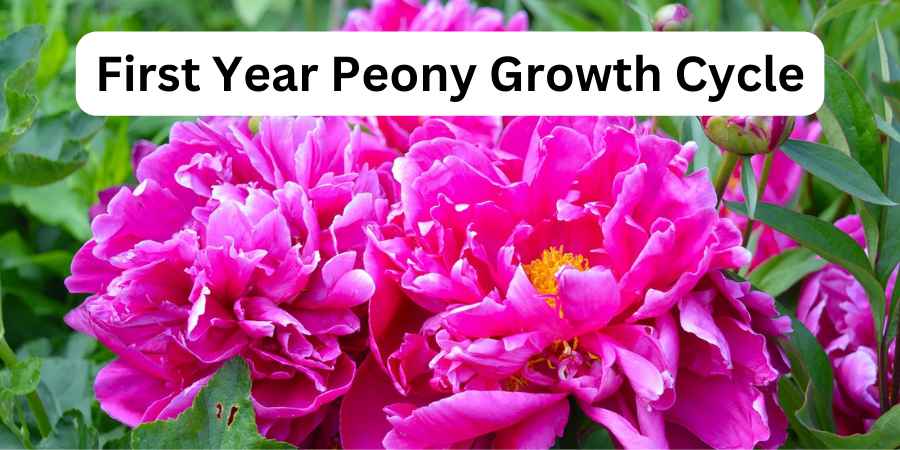Last Updated on June 19, 2025 by Jocelyn
Peonies are planted in early spring as bare roots with 3–5 eyes, placed about 2 inches deep. They prefer partial sun, unlike heat-sensitive plants such as jalapeños.
Throughout the first year, visible growth is mostly limited to foliage, while underground, roots grow deeper to establish a strong foundation.
By fall, the plant starts preparing for dormancy. A cold winter is necessary for resetting its growth cycle; without it, especially in warmer zones like 9B, development may be uneven.
Although seed pods might appear late in the season, flowering is uncommon until the second year, when the plant’s energy shifts toward producing blooms.
Table of Contents
ToggleFirst Year Peony Growth Cycle – Expert Insights!
Peonies are fascinating plants with a unique growth cycle that captivates gardeners worldwide. Learning about these stages helps in growing beautiful peonies and ensures they survive and flourish in your garden.
Let’s explore their journey from dormancy to bloom!
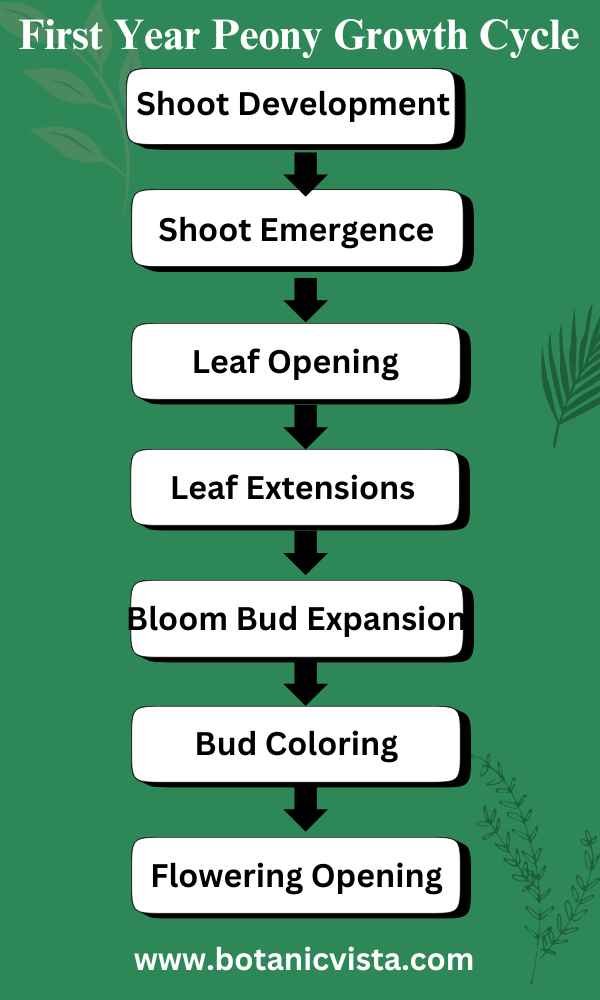
1. Shoot Development
Shoot development is a crucial stage in a plant’s life cycle, where shoots emerge from the soil and begin to grow. Careful watering is necessary to avoid waterlogging, which can lead to rot.
Shoots require appropriate temperatures to grow; cold or frosty conditions can cause dormancy, stopping growth until conditions improve.
Using mulch can help retain soil moisture, especially during winter, preventing the soil from drying out. Warmer temperatures encourage growth, but excessive heat can cause damage.
Monitoring soil moisture and providing sufficient water without overwatering is essential for nutrient absorption and healthy shoot regrowth.
Over a period of 7-10 days, significant changes can be observed in the shoots as they respond to the environment.
2. Shoot Emergence
In the first year, peonies start with tiny shoots pushing through the soil. This nascent phase begins as the stems emerge from beneath the ground.
Protect these shoots from frost and obstruction by ensuring they are not covered and providing necessary protection during the coldest days.
As the shoots gain momentum, they stretch and grow leaves. This growth over a few days feels like a miracle. Peonies need space and regular watering. Make sure they are not covered with cloth or debris.
Observing the emerging shoots and their gradual growth is a delightful experience, showcasing the beauty of nurturing new plants.
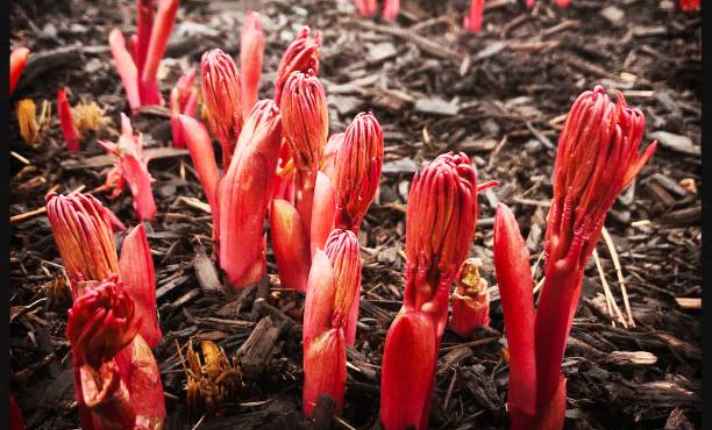
3. Leaf Opening
When peony leaves first come out, they look small and green. They slowly open up, showing their full size. Leaves are very important for the plant to make food. It’s exciting to see the change every day.
As spring begins, usually around late March to early April, tiny, tightly rolled leaves emerge, hinting at the growth to come. This initial uncurling of leaves is a sign that the plant is leaving its winter rest.
During this stage, it’s important to ensure the soil is not waterlogged and to protect the young shoots from late frosts, which can damage the tender foliage.
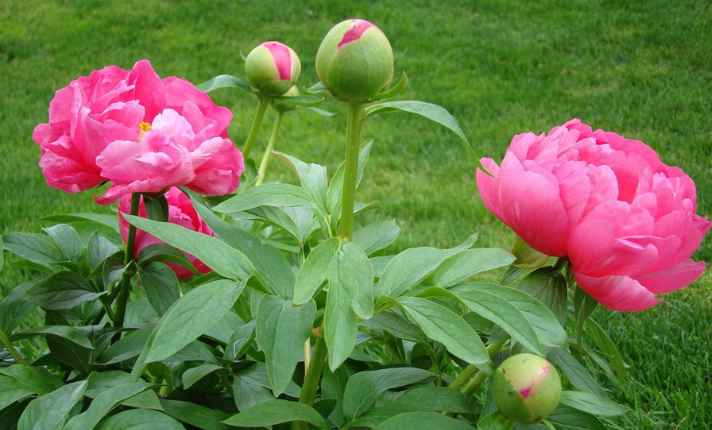
4. Leaf Extension
Following the leaf opening, the leaves expand rapidly throughout April and May. This larger surface area allows the peony to absorb more sunlight, which is crucial for its growth and health.
At this stage, peonies benefit from a balanced fertilizer to support their vigorous growth. Regular watering, especially in dry spells, is key, but be mindful to avoid wetting the foliage to prevent fungal diseases.
5. Bloom Bud Expansion
During the bloom bud expansion stage in late May to early June, peony buds grow and start to show color, preparing to bloom. This 2-3 week period requires careful attention to support, watering, and pest control.
Staking the stems early helps prevent damage from the buds’ increasing weight. Consistent, moderate watering is crucial to keep the soil moist but not waterlogged, avoiding root issues.
Regularly checking for pests like aphids and treating them gently if found ensures the buds remain healthy and ready for a vibrant bloom.

6. Bud Coloring
As the buds grow and the expected bloom time nears, they begin to show color. This color deepens and becomes more vibrant as the bud matures, signaling that the bloom is almost ready to open.
During this time, usually in early to mid-June, it’s vital to continue monitoring for pests such as aphids, which can damage the buds. Gentle support and minimal handling help preserve the bud’s integrity.

7. Flower Opening
In the first year, the peony starts its growth. The buds slowly form, showcasing their potential. The energy is directed to the root for healthier growth. This stage takes several weeks.
When the buds open, it’s a breathtaking moment. The transformation is dramatic. In just 1-3 days, the blooms reach their final glory. The timelapse of this burst of beauty is amazing.
Different cultivars have unique features. Some encapsulate the season’s characteristics with their resplendent display of blooms. Care is crucial during this period to ensure a longer season of beauty.
Once the blooms are spent, it’s important to deadhead. This encourages new growth. Timelapse videos of this lifecycle are a perfect way to see the dramatic stage changes. Keep the foliage healthy with regular care.
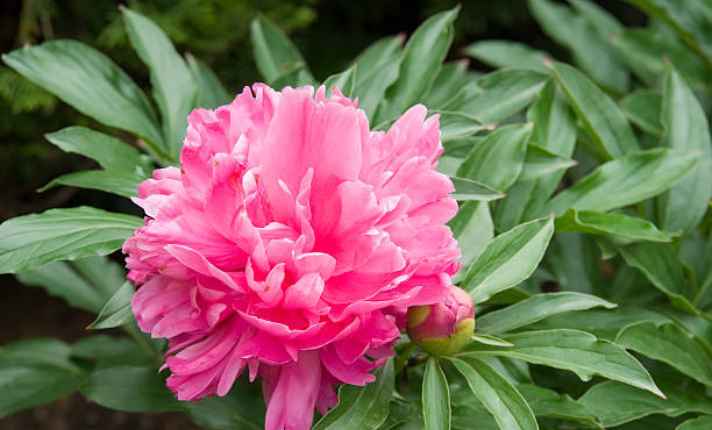
Tips for Growing Healthy Peonies
Planting peonies properly is key for their first year. Here’s how you can help them grow strong and beautiful. Follow these steps to ensure your peonies get the best start possible.
| Step | Tips |
| Choose the Right Spot | Peonies need well-drained soil. They prefer full sun, but some shade is okay. |
| Prepare the Soil | Use amended soil with compost. Avoid heavy clay; if you have clay soil, mix in organic matter. |
| Planting Depth and Space | Dig a hole about 2 feet wide and deep. Ensure the eyes of the root are about 2 inches below the surface. Leave enough space between plants for air circulation. |
| Watering and Care | Water regularly, especially during dry spells. Backfilling the hole with soil gently, to avoid damaging the roots. |
| Fall and Winter Care | Cut back leaves in the fall to avoid disease. Add a light layer of compost before the ground freezes. |
FAQ’s
Q: Which Is the Best Month to Grow Peonies?
A: The best month to grow peonies is October. This allows them to establish roots before winter. Planting in the fall gives peonies a strong start in the spring.
Q: How Long Does It Take for Peony Bulbs to Come Up?
A: Peony bulbs could take a year to show their first blooms because they need time to get established. They start growing roots and leaves in the first year and may begin blooming in the second year.
Q: Why Do Peonies Take So Long to Bloom?
A: Peonies take time to bloom because they need to establish their roots first. Ensure the crown buds are planted 2 inches below the surface and not too deeply or upside down.
Adding compost helps in poor soil, but don’t bury the crown buds too deeply.
Q: Do Peonies Bloom the First Year After Planting?
A: Peonies focus on developing a strong root system and healthy foliage in the first year. By the second spring after being newly planted, they will start to bloom if planted in the right site.
Q: What Is the Best Fertilizer for Peonies?
A: Use a 10-10-10 fertilizer like Gardenwise for peonies. Follow the recommended amounts, and add it in spring to give the plants balanced nutrients of NPK. This helps peonies grow strong and healthy.
Conclusion
Watching peonies grow in the first year of gardening is a special experience. It’s a privilege to witness the sheer beauty of these flowers. The initial stages require care, but the journey is worth it.
Seeing the transformation of a peony is like a timelapse of nature’s wonders. As shoots appear, they begin their slow but steady development. Each bloom is a testament to the gardener’s dedication.
Gardening with peonies is full of important moments. The stages of growth amaze and inspire. This timelapse of nature’s beauty never ceases to surprise.
Learn more:
